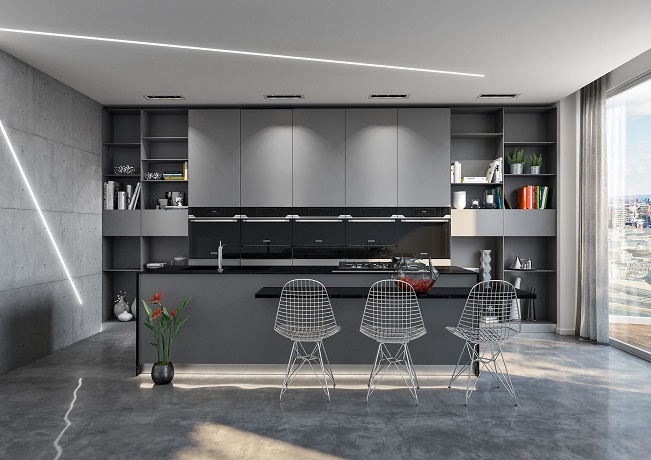
The kitchen is one of the most important rooms in our home. It’s the place where the family gathers, where the meals that bring us together are cooked. Where kids help their mums set the table. Where dads tell the funniest jokes and grandmas make the most delicious cookies. So, we try to make it as pleasant as possible, and as practical as possible. Choosing the right tiles, flooring and backsplash can make a huge difference in this regard.
The Best Kitchen Floor Tile Materials
When choosing the best floor kitchen tiles for your space, there are a lot of factors to consider. Colour, shape, material, maintenance, water resistance, your household’s lifestyle and of course your budget are the most important ones. Surely taking all of this into consideration can be overwhelming when you’re going through the process of remodelling or building the kitchen. But we’re here to help you!
Vinyl
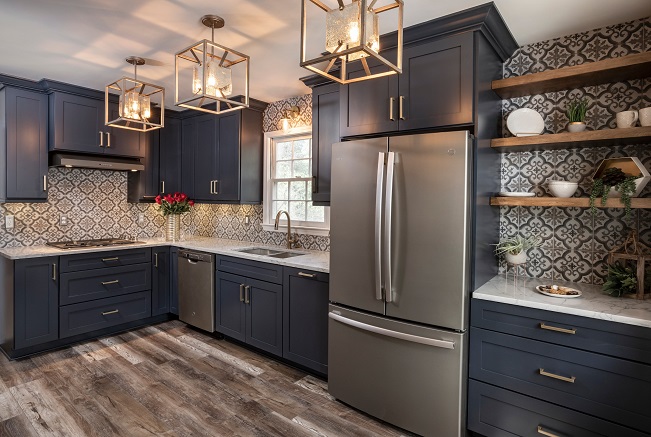
Vinyl is a popular choice for kitchens. If you’re on a tight budget, vinyl is the best option for this room. As a material it is cheap, but it doesn’t necessarily mean that it will look cheap when installed. Actually, nowadays there are highly modern vinyl tile styles that come in many colours and imitate the look of wood, stone or marble. Vinyl is also easily installed, so this can be one DIY project you can enjoy.
Vinyl is waterproof and water-resistant so you don’t have to worry about any spillage. If you splash and spill something on it, just sweep it with a dry towel and that will do the trick. We must say that this type of floor kitchen tile is susceptible to scratches, but with frequent sweeping and wet mopping, it is guaranteed that it will last for many years to come.
Another good thing about vinyl is that it’s quite resilient. This means slightly softer floors that can ease fatigue and make the time spent in the kitchen more enjoyable and meal prep time faster. Because of its soft side, you don’t have to worry when a glass or a plate drops on this flooring for the kitchen, chances are, it will just bounce and not have a scratch in sight.
Ceramic
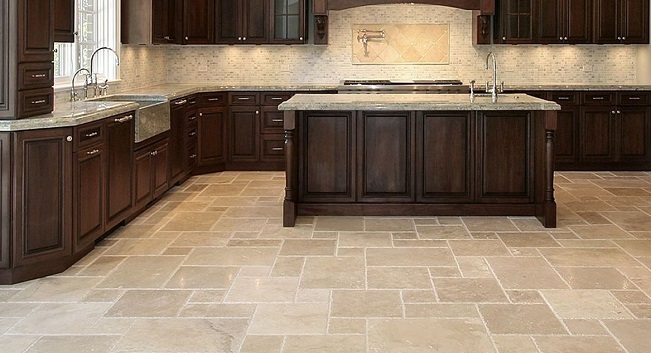
Ceramic is one of the most used kitchen tile materials. The first reason is its price, which is right in the middle and it’s affordable for almost anyone. And the second one is its diversity in usage. It can be used for flooring, it’s ideal for backsplashes and when used as a countertop it’s very durable and can hold up the heat. But maybe the biggest reason for its popularity is the fact that it’s water-resistant and stain-resistant. Ceramic tiles are made from clays, are a bit softer than porcelain tiles and can be glazed to create a durable surface in almost any colour. Not just in colour, they can come in different styles and different durability levels. When you’re looking for floor tiles specifically, look for the ones that are fired twice and have a matte finish. That way your floors will be more durable.
Because of the glazing, these tiles are non-porous, don’t absorb water, smells and humidity, and are also stain resistant. When it comes to cleaning and maintaining, they are pretty simple. Having a huge choice of colours, shapes and designs you can mix and match and create anything you can imagine and have a unique kitchen.
The only drawback is its weight and hardness. It’s not easy to work with this material when the kitchen is in the upper stores. It can also be uncomfortable to stand on it for a longer period of time.
Porcelain
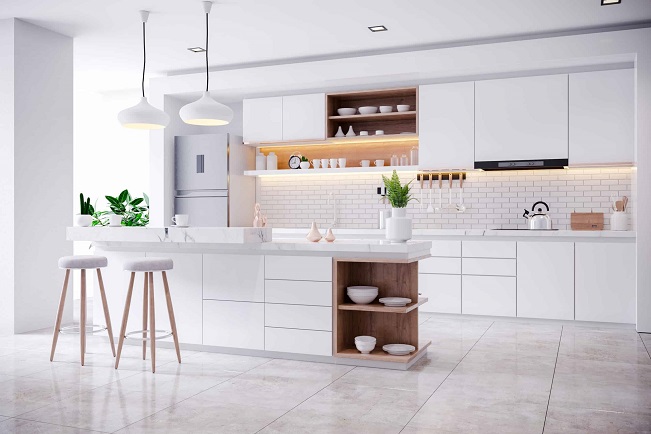
Porcelain tiles are number one when it comes to durability and good looks. Similar to ceramic they are made from compressed clay dust, but their manufacturing process takes porcelain tiles to the next level. Because they are fired at a much higher temperature than ceramic tiles, porcelain tiles are denser, harder, less porous, more durable and water-resistant, and hard to wear.
They come in two styles, glazed and unglazed. Glazed tiles have a glass-like coating that is added to them during the process of firing, and this produces its coloured surface, which can be in any colour you want. Unglazed porcelain tiles keep the earthy colour of the clays that are used to make them. Any scratches made on them won’t be noticed.
These tiles are a great choice for high-traffic areas, like bathrooms and kitchens, but are also durable enough to be placed outside and withstand all weather conditions. Moreover, taking care of them is easy – cleaning them requires some sweeping and mopping with a damp rag from time to time. But if you take good care of it, they will last for decades.
The two only downsides that porcelain tiles have are their weight and initialization. Heavy as it is, it’s very hard to work with if the floor is on the upper floors. And it can be hard to install because it requires special tools and knowledge.
Marble
If your style is elegant and sophisticated, then marble is the right choice for you. It gives the modern and luxurious look of the kitchen. Marble comes in different greys and whites, but the dark shades are splendid and project a super-chic style. Also, the veining on the tiles can be strikingly dramatic and noticeable.
Marble is one of the most expensive flooring materials. It’s not just buying the raw material, but the instalment is also pricy. And if you want some kind of mosaic or a complex part, get ready to pay for it. Because of its price you’d think the setbacks are almost none, well think twice. On one hand, marble is waterproof, but on the other hand, it is extremely slippery when wet. Some types of marble are even slippery when dry. Another thing that is a setback, it’s the fact that marble is susceptible to staining and scratching. You would have to do sealing from time to time, to make sure the tear and damage are as minimal as possible.
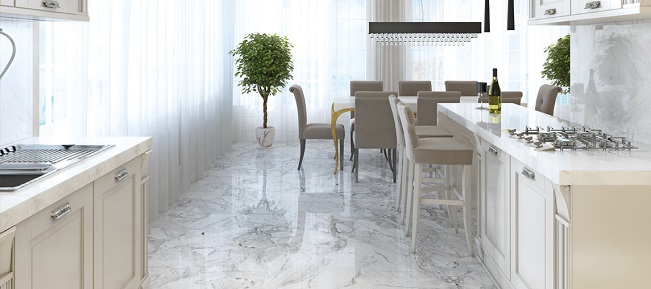
Granite
Just as marble, granite and all of the other stone kitchen tiles, bring warmth and beauty to your home. It looks luxurious, especially when you match the flooring with the countertop. It is available in a variety of colours that can give the kitchen an upscale look.
Granite is durable, can resist heavy impacts and it’s stain-resistant. For a longer lifespan of the granite floors, the tiles should be sealed and constantly maintained.
The downsides of this material are its slipperiness, pricing, coldness and if you drop something on it, it will break without a doubt.
What Is The Optimal Flooring Choice?
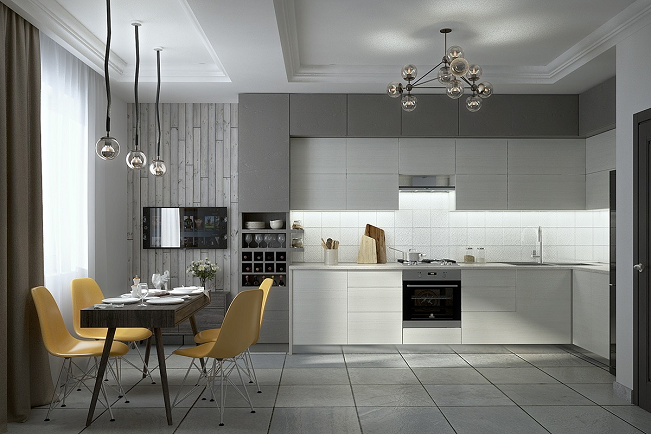
Our suggestion for floor kitchen tiles material would be ceramic. It’s affordable, water-resistant, durable and easy to clean. But as we said earlier, you need to consider your lifestyle and budget to make a decision. Buying new kitchen flooring shouldn’t be scary or intimidating. Don’t be scared of all of the options, explore, test, consult and when you’re ready, buy and enjoy your new favourite place.
























